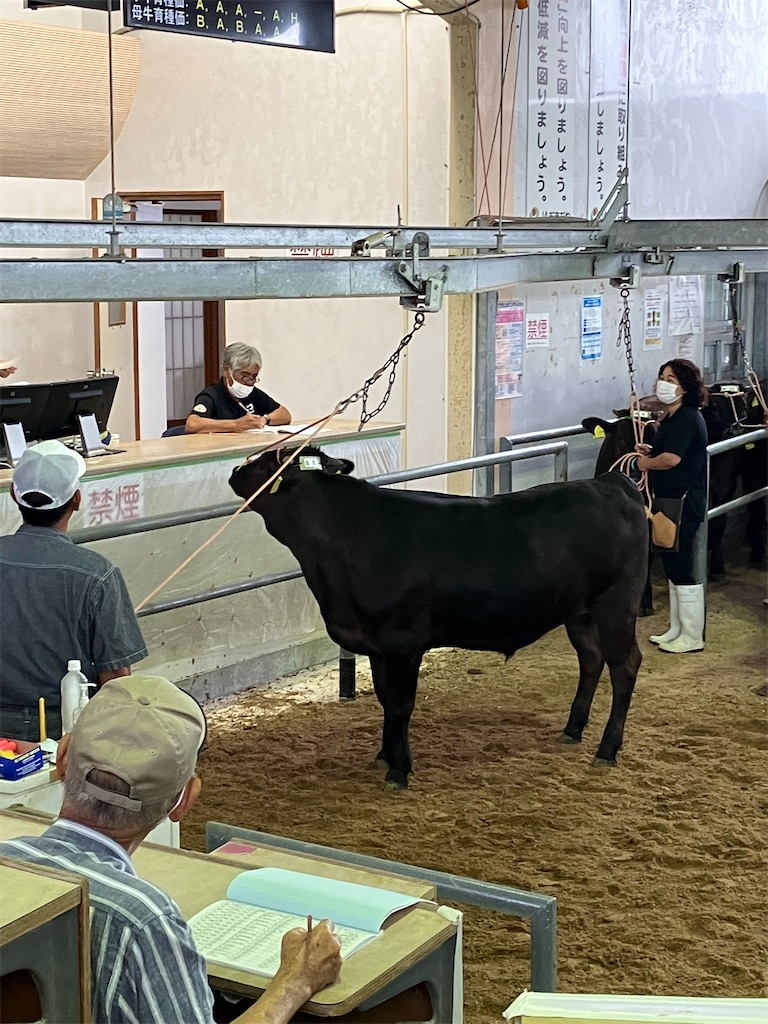
関係者の方に連れて行ってもらい、初めて牛のセリを見学させてもらいました。
この日は何百頭だったかしら?
400頭を超える牛たちがどんどんせりにかけられました。
はじめのほうは、子牛から。
流れ作業でどんどん競りにかけられて行きます。
何度もセリにかけられるのを見ながら、目を肥やしていき、価格の相場をつかみます。
途中からはこの牛はいくらつくかなぁって予想してからセリの結果を見つめました。
今回は、全般的に価格が低くなり、売り手の農家さんはがっかり、買い手にはうれしい結果になったようです。
家畜の飼料は高騰しているのに価格は下落なんて、農家さんには本当にしんどい状況になっているんですね。
私は時々、牛を飼って育て、その牛を市場に出すと言う肥育農家さんのYouTubeを見ているので、どうしても気持ちが牛を育てる農家さんのほうに行ってしまい、こんな安く買われるのはかわいそうと思う時もありました。
もちろん、あまりに安い価格しかつかないと、出荷した農家さんが売るのをやめると言うこともできるようで、少しほっとしました。
クイズです:雌牛と雄牛、どちらが高値がつくでしょう?
雌牛は、子供を産むことができるからを私よりも高く評価されるのかなあと思っていたら、
一般的に、雄牛(去勢済み)の方が大きいから、それだけ多くのお肉が取れる=値段が高くなると言う仕組みだよと教えてもらいました。
なるほど!
他にも、同じような体格だととして、背が高い子牛の方が高く売れるのは、
背が高いと、それだけ成長する余地がある=お肉をたくさん取る事ができる。と言う理論だよ、とも教えてもらいました。
体格や体重はポイントだけど、なんといっても、高値をつける一番のポイントは血統!これに尽きると教えてもらいました。
そして競り落とされた牛さんたちは宮崎や三重県など、牛で有名な産地に船で出荷されるそうです。そこで育てられて、現地の名前を冠した牛として流通にのっていくようです。例:宮崎牛、松坂牛、など。
牛の競りのライブ配信が、農協さんのホームページから見れるようなので、リンクを貼っておきます。(過去の配信はなし。ライブ配信のみ。)
http://www.oki-seri.jp/cms/public/top.php
また、時々私が見ている石垣島の肥育農家さんのYouTubeのページはこちらです↓
そして、こちらの動画を見て知ったのですが、
出荷される牛さんたち、飲まず食わず、糞尿垂れ流し、空調もないコンテナで(窓は開いてます)長い時間かけて日本本土まで運搬されるそうです。
見てるとかわいそうになりました。暑いだろうな、臭いだろうな…って。
私になにかできることはないのでしょうか?一週間のうち一日でも動物のお肉を食べないこと?くらいしか思いつきません。
動画の説明文から引用↓
”競り落とされた牛はそれぞれの購買先へ輸送されるのですが、 石垣島から那覇港までは13時間、那覇港から鹿児島港まで20時間かかり、那覇港の待機時間を含めると42時間の長距離の輸送です。 熱中症や転倒など牛の安全面が懸念されます。”
I was fortunate to be taken by someone involved and had the opportunity to visit a cattle auction for the first time.
I wonder how many head of cattle there were on that day?
Over 400 cattle were steadily brought to the auction.
They started with the calves.
The process flowed continuously as they were auctioned off.
While watching them being auctioned multiple times, I observed closely and familiarized myself with the price trends.
From midway, I began predicting how much each cow would fetch before seeing the auction results.
This time, the prices were generally low, which left the selling farmers disappointed but brought joy to the buyers.
It's truly a difficult situation for the farmers when the cost of livestock feed is soaring while the prices are declining.
As I occasionally watch YouTube videos of farmers who raise and sell cattle, I can't help but sympathize more with the farmers who raise the cattle, thinking it's unfortunate that they are sold at such low prices.
Of course, if the prices they receive are consistently too low, the farmers who shipped the cattle can choose to stop selling, which provided a little relief.
Now, here's a quiz: Which one, female or male cattle, fetches higher prices?
I thought female cattle would be more highly valued because they can give birth to offspring.
However, generally, castrated male cattle (steers) tend to be larger, which means they can provide more meat, resulting in higher prices. That's the mechanism behind it, as I was told. I see!
In addition, among cattle with similar physique, taller calves tend to sell for higher prices.
The theory is that taller calves have more room for growth, allowing them to produce more meat, as I learned.
Physique and weight are important factors, but ultimately, the most significant factor for commanding high prices is the lineage. That's what I was told.
The cattle that were auctioned off are then transported by ship to famous cattle-producing regions such as Miyazaki and Mie Prefecture. They are raised there and sold under the name of the local region, such as "Miyazaki Beef" or "Matsusaka Beef."
I found out that the live streaming of cattle auctions is available on the agricultural cooperative's website, so I'll provide the link for you. (There are no past recordings, only live streams.)
http://www.oki-seri.jp/cms/public/top.php
Also, here's the YouTube page of a cattle farmer on Ishigaki Island that I occasionally watch:
https://www.youtube.com/@ushikimo
Furthermore, from watching these videos, I learned that the transported cattle endure long journeys to mainland Japan in containers without food or water, with their excrement flowing and no air conditioning (though the windows are open).
It made me feel sorry for them. It must be hot and smelly...
Is there anything I can do to help? Perhaps not eating meat from animals for at least one day a week? That's the only idea that comes to mind.
Quoting from the video description:
"After being auctioned, the cattle are transported to their respective purchasers. From Ishigaki Island to Naha Port, it takes 13 hours, from Naha Port to Kagoshima Port, it takes 20 hours, and considering the waiting time at Naha Port, it amounts to a long-distance transportation of 42 hours. Concerns arise regarding the safety of the cattle, such as heatstroke and falls."